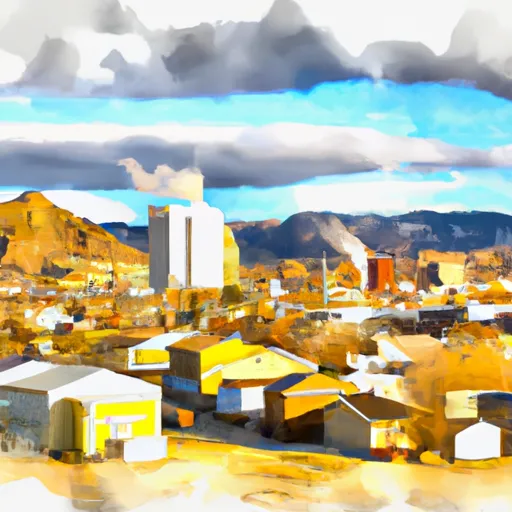-
 Snoflo Premium
Snoflo Premium
Get unlimited access to all our content
With no Ad interruptions! - Start Your Free Trial Login with existing account
Silver-City
Eden Index
Climate
8.5
•
Recreation
5.5
•
Community
3.9
•
Safeguard
6.3/10

Silver City, Nevada is a small historic town nestled in the western United States. Known for its unique climate and stunning natural surroundings, it offers a variety of outdoor recreation opportunities. The town experiences a semi-arid climate, characterized by hot and dry summers and mild winters. Summers typically reach temperatures of around 90°F, while winters see mild days with temperatures ranging from 40-60°F.
Hydrologically, Silver City is situated near the Carson River and is surrounded by the majestic Sierra Nevada Mountains. The area boasts abundant water resources, including streams, creeks, and reservoirs, making it an ideal destination for fishing, boating, and other water-related activities. The nearby mountains provide ample opportunities for hiking, camping, and wildlife observation.
Outdoor enthusiasts will find a multitude of recreational options in Silver City, from exploring the historic mining sites and ghost towns to mountain biking along the numerous trails. The region's diverse landscape provides ample opportunities for rock climbing, off-roading, and even winter activities such as skiing and snowboarding in the nearby mountain resorts.
Overall, Silver City, Nevada offers a unique blend of climate, hydrology, and outdoor recreational opportunities that make it an attractive destination for nature lovers and adventure seekers alike.
What is the Eden Index?
The Snoflo Eden Index serves as a comprehensive rating system for regions, evaluating their desirability through a holistic assessment of climate health, outdoor recreation opportunities, and natural disaster risk, acknowledging the profound impact of these factors on livability and well-being.
Climate Health Indicator (CHI): 8.5
Silver-City receives approximately
278mm of rain per year,
with humidity levels near 60%
and air temperatures averaging around
10°C.
Silver-City has a plant hardyness factor of
7, meaning
plants and agriculture in this region tend to thrive during the non-winter months.
By considering the ideal temperature range, reliable water supplies, clean air, and stable seasonal rain or snowpacks, the Climate Health Indicator (CHI) underscores the significance of a healthy climate as the foundation for quality living.
A healthy climate is paramount for ensuring a high quality of life and livability in a region, fostering both physical well-being and environmental harmony. This can be characterized by ideal temperatures, reliable access to water supplies, clean air, and consistent seasonal rain or snowpacks.
Weather Forecast
Streamflow Conditions
Carson
Area Rivers
Carson
Snowpack Depths
Carson
Reservoir Storage Capacity
Carson
Groundwater Levels
Recreational Opportunity Index (ROI): 5.5
The Recreational Opportunity Index (ROI) recognizes the value of outdoor recreational options, such as parks, hiking trails, camping sites, and fishing spots, while acknowledging that climate plays a pivotal role in ensuring the comfort and consistency of these experiences.
Access to outdoor recreational opportunities, encompassing activities such as parks, hiking, camping, and fishing, is crucial for overall well-being, and the climate plays a pivotal role in enabling and enhancing these experiences, ensuring that individuals can engage in nature-based activities comfortably and consistently.
Camping Areas
| Campground | Campsites | Reservations | Toilets | Showers | Elevation |
|---|---|---|---|---|---|
| Dayton State Park | 10 | 4,329 ft | |||
| Davis Creek | 63 | 5,171 ft | |||
| Washoe Lake State Rec Area | 49 | 5,056 ft |
Nearby Ski Areas
Catastrophe Safeguard Index (CSI):
The Catastrophe Safeguard Index (CSI) recognizes that natural disaster risk, encompassing floods, fires, hurricanes, and tornadoes, can drastically affect safety and the overall appeal of an area.
The level of natural disaster risk in a region significantly affects safety and the overall livability, with climate change amplifying these risks by potentially increasing the frequency and intensity of events like floods, fires, hurricanes, and tornadoes, thereby posing substantial challenges to community resilience and well-being.
Community Resilience Indicator (CRI): 3.9
The Community Resilience Indicator (CRI) recognizes that education, healthcare, and socioeconomics are crucial to the well-being of a region. The CRI acknowledges the profound impact of these elements on residents' overall quality of life. By evaluating educational resources, healthcare accessibility, and economic inclusivity, the index captures the essential aspects that contribute to a thriving community, fostering resident satisfaction, equity, and social cohesion.

